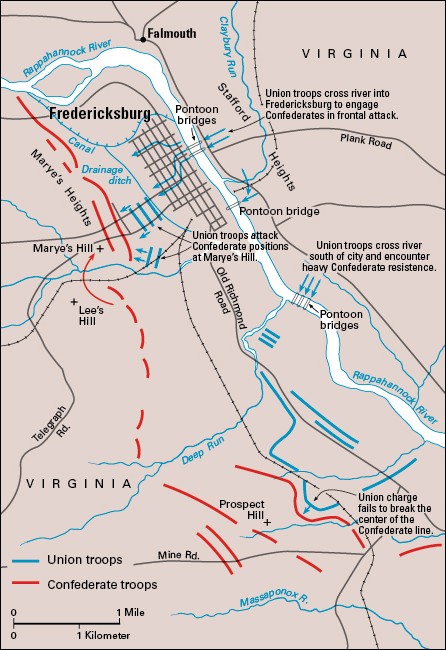Fredericksburg, Battle of, was one of the worst defeats of the Union Army during the American Civil War (1861-1865). The battle, which took place in northeastern Virginia in December 1862, is named after the town on the battlefield. Confederate forces led by General Robert E. Lee defeated a larger Union army commanded by General Ambrose E. Burnside. In the battle, Union forces suffered more than twice as many casualties as the Confederates.

On Sept. 17, 1862, Union forces led by General George B. McClellan defeated Confederate forces under Lee at the Battle of Antietam (also called the Battle of Sharpsburg) in Maryland. The day after Antietam, Lee’s army began its retreat to Virginia. There, Lee rested and reorganized his troops. Even though McClellan’s army was at that point larger than Lee’s, McClellan did not immediately pursue him.
In late October, McClellan’s army finally left Maryland and headed south toward the Confederate capital at Richmond, Virginia. In response to the Union troop movement, Lee divided his army. He sent troops under Confederate General James Longstreet to a location between McClellan’s troops and Richmond. Lee also left troops under Confederate General Stonewall Jackson in Virginia’s Shenandoah Valley to protect the Confederates’ food supply.
President Abraham Lincoln became dissatisfied with McClellan, and on November 7, he replaced McClellan with Burnside. Burnside planned to move his 120,000 Union troops southeast, so that they could cross the Rappahannock River into Fredericksburg and then continue south toward Richmond. Burnside hoped to be across the river before Lee could intervene. On November 15, Burnside’s army began its march toward Fredericksburg. By November 17, Burnside’s troops had begun arriving at Stafford Heights, just across the Rappahannock from Fredericksburg.

Because the bridges across the Rappahannock had been destroyed earlier in the war, Burnside had arranged to have pontoon bridges (temporary floating bridges) meet the army at Stafford Heights. However, Burnside’s plans were delayed by the late arrival of the bridges. By the time they arrived, more than a week later, Lee’s army of 75,000 troops had begun to move into position to block the Union army from advancing beyond the town of Fredericksburg.
Burnside planned two attacks across the Rappahannock. For one of the attacks, he planned for troops led by Union General William Franklin to cross pontoon bridges a couple of miles south of Fredericksburg, where they would begin fighting Jackson’s forces. For the other attack, troops under Union Generals Edwin Sumner and Joseph Hooker would cross pontoon bridges directly in front of Fredericksburg. They would then pass through Fredericksburg and attack Longstreet’s troops on Marye’s Heights, an area of high ground west of the city. However, because Lee’s army had arrived before Burnside’s troops had crossed the river, many of Burnside’s subordinate officers did not think the attacks would be successful.
On December 11, Union engineers began building the pontoon bridges across the Rappahannock. The Northerners had little trouble with the bridges south of the city, but the Union engineers directly in front of Fredericksburg were attacked by Confederate sharpshooters hiding in the houses of Fredericksburg. In an effort to displace the sharpshooters, Union artillery fired for two hours at Fredericksburg, but the sharpshooters returned when Union engineers resumed work. Burnside then sent Union troops across the Rappahannock in boats to chase away the Confederates and to allow the engineers to finish the bridges.
On December 12, Burnside moved a large number of troops into Fredericksburg. This took time, and while long columns of troops continued to march across the bridges, many of the Union troops already across spent the day looting the town. The next day, Union troops attacked the Confederates at the two positions they had planned. South of Fredericksburg, Franklin sent only a small portion of his troops against Jackson. Franklin’s troops were initially successful but eventually were stopped and pushed back toward the Rappahannock.
At Fredericksburg, Union troops attacked the Confederates on Marye’s Heights. To make the assault, the Northerners advanced on an open plain and had to cross two bridges over a drainage ditch. They then headed toward a stone wall from which Confederate infantry, four deep, were firing at them. At the same time, Confederate artillery was firing over the Confederate infantry at the Union troops.
The Union troops making this attack were slaughtered. However, Burnside continued to send repeated attacks against Marye’s Heights until nightfall. The next day, Burnside himself wanted to lead an attack against the position, but his subordinate officers talked him out of doing so. Watching from Marye’s Heights, Lee said, “It is well that war is so terrible. We should grow too fond of it.” On December 15, Burnside withdrew his army east across the Rappahannock.
During the course of the battle, the Union army suffered approximately 13,000 casualties, mostly in front of Marye’s Heights. The Confederates suffered about 5,000. These casualty figures were among the most lopsided of any of the Civil War’s major battles. In January 1863, Lincoln replaced Burnside with Joseph Hooker. The Union and Confederate armies stayed on opposite sides of the Rappahannock until the spring of 1863, when Hooker attacked Lee at the Battle of Chancellorsville.
See also Burnside, Ambrose Everett ; Civil War, American ; Hooker, Joseph ; Lee, Robert E. .
